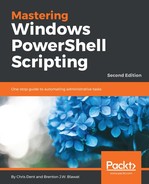When the inputs and outputs of a function are being repetitively tested, the TestCases parameter of It can be used. Test cases are defined in a hashtable, which is splatted into It as a set of parameters.
The four test cases used in the preceding example might be rewritten as follows:
$testCases = @(
@{ Value = 1; ExpectedResult = 1 }
@{ Value = 4; ExpectedResult = 2 }
@{ Value = 9; ExpectedResult = 33 }
@{ Value = 16; ExpectedResult = 44 }
)
It 'Calculates the square root of <Value>to be<ExpectedResult>' -TestCases $testCases {
param (
$Value,
$ExpectedResult
)
Get-SquareRoot $Value | Should -Be $ExpectedResult
}
The preceding tests still contain errors; the advantage of this approach is that Pester will report success or failure for each of the test cases individually:
Describing Get-SquareRoot
[+] Returns a square root of 0 for a value of 0 37ms
[+] Calculates the square root of 1 to be 1 20ms
[+] Calculates the square root of 4 to be 2 11ms
[-] Calculates the square root of 9 to be 33 16ms
Expected: {33}
But was: {3}
at <ScriptBlock>, : line 41
41: Get-SquareRoot $Value | Should Be $ExpectedResult
[-] Calculates the square root of 16 to be 44 35ms
Expected: {44}
But was: {4}
at <ScriptBlock>, : line 41
41: Get-SquareRoot $Value | Should Be $ExpectedResult
Pester automatically replaces values enclosed in angular braces (< and &gt;) with names from the hashtable describing each test case.
Using test cases can save time spent debugging code and tests, as fewer runs are needed to highlight problems.
